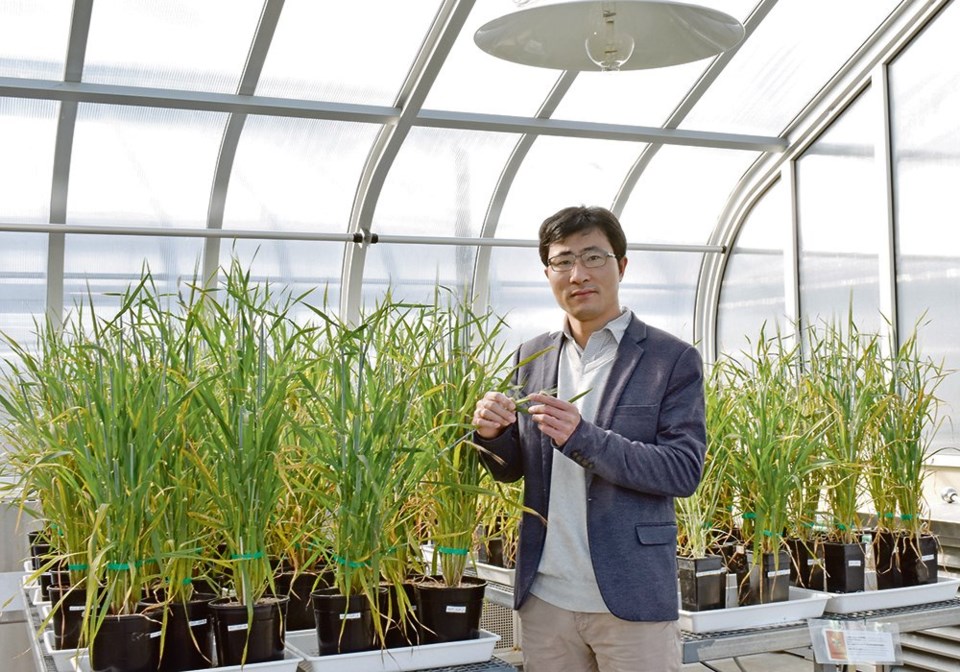At the University of Adelaide’s Waite Research Institute, researchers collaborated with the Shanghai Jiao Tong University’s Joint Lab for Plant Science and Breeding to find ways to increase seed production in plants that respond to high temperatures.
“Our lab is working on the molecular mechanism of inflorescence development in cereals,” said Gang Li in the School of Agriculture, Food and Wine. “Cereal crops such as wheat and barley are worth over $12 billion to the Australian economy.”
He said that the architecture of cereal inflorescence shows striking diversity ranging from a highly compact spike in barley and wheat to the more branched panicle in rice. On a spike, the grains are closely packed together and linked to a central axis.
“If we could alter the compact nature of the spike of wheat and barley to make branches with more room to set grain, we might be able to produce significant yield increases,” said Li. “Optimum growth temperatures for grasses such as (corn) and rice with branched inflorescences are uniformly higher than for species with unbranched inflorescences such as wheat and barley. We speculated that branching or non-branching structures may be associated with temperature cues.”
They discovered that a barley protein, known as HvMADS1, regulates the number of flowers generated on each barley spike in response to high temperatures.
In addition, they also showed that the protein is critical in maintaining an unbranched barley spike under high ambient temperatures.
He said that HvMADS1 in barley has a regulatory function in normal and high temperatures and it acts as a switch to control the gene expression of proteins during temperature changes. At high temperatures, the protein controls transcriptional changes that regulate spike branching development, restraining cell cycle/division activity and maintaining an unbranched barley spike.
In their experiment, the research team proved that, with the removal of HvMADS1 using the gene editing CRISPR/Cas9 system in three barley varieties, the process effectively converted an unbranched barley spike into a branched spike bearing more flowers.
“Our CRISPR/Cas9 system is working very well in barley with a high target gene-editing efficiency (90-100 percent),” said Li. “We made the mutants with different alleles of HvMADS1 including loss of (the protein’s) function. This could ultimately result in the production of more grain per plant.”
He said that the protein has the regulatory function in both normal and high temperatures. Loss of the protein through gene editing affected only the awn, or bristle, elongation of the spikelet at control temperatures, suggesting the role of HvMADS1 is in awn development regardless of temperature.
“At a high temperature, MADS1 fulfils its function by controlling the changes that regulate spike branching development,” he said.
In the process of generating the mutant plants with the focus on the barley spikes, the team realized that the gene had an effect on whole plant development, such as tiller number.
“When it came to the number of tillers, there was an increase present in the mutant without the HvMADS1 protein compared to the regular plant,” he said. “For example, in one single plant with the wild-type protein, the average tiller number was six producing an average 180 seeds per plant. The average tiller number in our mutant plants was eight to 10 resulting in an average 250 seeds per plant. The seed size was a bit smaller in the plants without the HvMADS1 protein, both at high and normal temperature. We believe that the protein also regulates the seeds’ development during barley reproduction.”
The study offers new avenues for crop breeding potential to overcome the traditional compromises between heat tolerance and the need for high yield.
The work has generated considerable interest from Australian breeding companies. Li said they have asked for some barley varieties without the HvMADS1 protein for further breeding tests.
“This protein is evident in the germplasm of all barley varieties,” he said. “We investigated a variation database that includes more than 20,000 barley varieties and this protein existed in all varieties. Thus, we may create new germplasms without HvMADS1 protein using the gene editing approach.”
The research team now plans to focus on the regulatory mechanism and breeding value of HvMADS1. In its molecular research it plans to work on the mechanisms by which the protein interacts with other proteins and downstream targets, such as the transcription factors and phytohormones in which they might have a controlling influence on the cluster of flowers on a barley spike in response to temperature.
The study was published in the journal Nature Plants.




